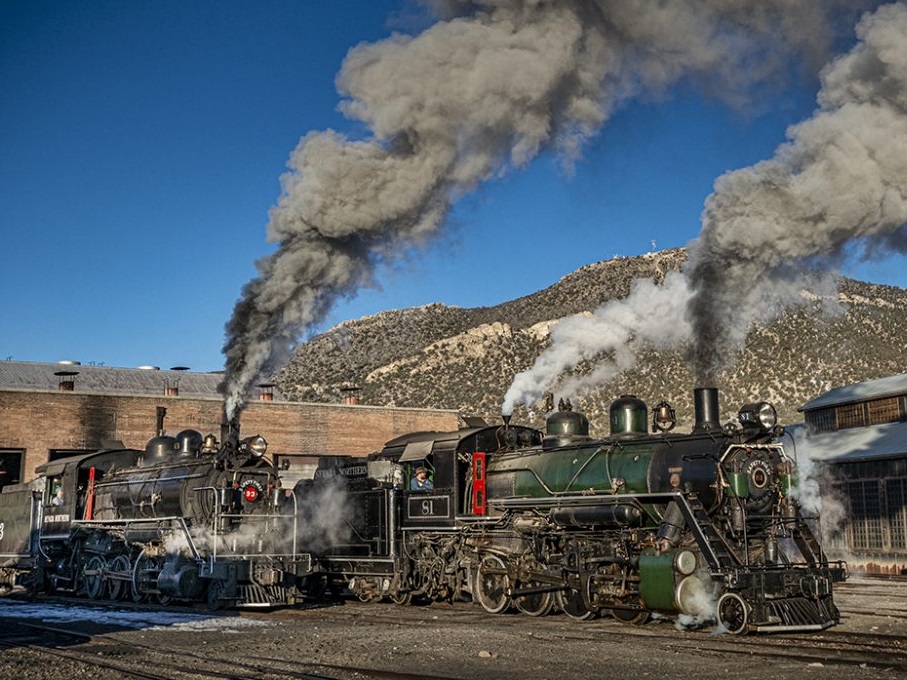Locomotive 93, once a powerful symbol of the golden age of steam, now resides in the quiet confines of the engine house, its steel frame resting in peace after decades of service. The engine house, a place once filled with the rumble of engines and the sounds of men working to keep these mechanical giants running, has become the final resting place for many of the great locomotives of yesteryear. Today, Locomotive 93 is a testament to the rich history of rail travel, preserved for future generations to admire and appreciate.

A Legacy in Motion
Locomotive 93, like many steam engines of its time, was built during an era when railroads were the backbone of transportation in the industrialized world. Its sleek and powerful design allowed it to pull heavy trains across long distances, carrying passengers and freight alike, connecting cities and communities. The steam engine revolutionized travel and commerce, shaping the world we live in today.
Built in the early 20th century, Locomotive 93 served with distinction on various rail lines, pulling trains through diverse landscapes. From the bustling cities to the open countryside, it played an essential role in moving goods and people. Over the years, however, as diesel and electric engines took over the role of the workhorse of the rails, steam locomotives like Locomotive 93 began to fade into history.
A Final Destination: The Engine House
Today, Locomotive 93 is housed in the engine house, a structure designed to provide shelter and maintenance for these magnificent machines. The engine house, now a quiet sanctuary for historical locomotives, is where enthusiasts and historians alike come to marvel at the craftsmanship and power of steam engines. Locomotive 93, with its towering presence and intricate design, stands as a reminder of the engineering ingenuity that propelled the world into the modern age.
In the engine house, Locomotive 93 is carefully maintained and preserved. It is a symbol of the era of steam, offering a glimpse into the past for those who visit. The engine is often showcased during special events and exhibits, where visitors can learn about the evolution of locomotives and their impact on history. For railroad enthusiasts, Locomotive 93 is more than just a relic of the past—it’s a living piece of history, a connection to a time when steam powered the world.
The Importance of Preservation
Locomotive 93’s place in the engine house serves as a reminder of the importance of preserving our industrial heritage. As technology advances and new innovations emerge, it’s easy to overlook the machines that once shaped our world. Yet, through careful preservation efforts, these locomotives continue to tell the story of human progress, of how railroads once bridged vast distances and brought people together.
Organizations dedicated to the preservation of steam locomotives, like railway museums and historical societies, work tirelessly to maintain these engines and educate the public about their significance. Locomotive 93, alongside many other historic trains, plays a vital role in keeping the memory of the steam era alive. The engine house, a repository of such history, allows visitors to step back in time and experience firsthand the power and majesty of these extraordinary machines.
Looking to the Future
As Locomotive 93 rests peacefully in the engine house, it serves as a bridge between the past and the future. The world of railroads has changed drastically since the heyday of steam, with high-speed trains and advanced technology now dominating the rails. Yet, steam locomotives like Locomotive 93 remind us of a time when the world was driven by the power of steam, and the railroads were a vital part of everyday life.
Locomotive 93 is more than just a machine; it is a symbol of innovation, dedication, and the tireless spirit of human ingenuity. Its place in the engine house ensures that its legacy will never be forgotten, and future generations will continue to marvel at the incredible advancements that brought us from the steam-powered trains of the past to the high-tech rail systems of today.
Conclusion
Locomotive 93 may no longer thunder down the tracks, but within the walls of the engine house, it lives on as a piece of history. The engine, with its steel framework and intricate machinery, stands as a testament to an era that shaped the world of transportation. Its presence in the engine house is a reminder that while technology may change, the stories of the past will continue to resonate for years to come. As long as we preserve these relics of the past, we can ensure that future generations will have the opportunity to experience the power and majesty of steam locomotives like Locomotive 93.
